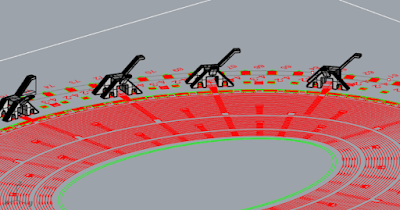The chicken and carrot soup that usually palliates such stomach illnesses didn’t work. In fact, it made it worse. 3 days into uncontrolled bowel movements I realized my system couldn’t handle any fiber at all... not even boiled carrots. So I ended up drinking a little clear chicken broth, and a couple spoons of plain yogurt every hour for 5 days before my body stabilized enough where I could handle egg yolks. By day eight I was eating a dozen egg yolks and soup. At the height of my stomach bug, I had lost 15 pounds, I thought I would never eat solid food again, plain yogurt never tasted so good held in my mouth, and I found myself daydreaming eating ramen and bananas like a normal human being.
Between my constant visits to toilet, I was feverishly preparing a fellowship application to do architectural research in Rome. I spoke to my first professor in school to see how he won the fellowship. He told me he had Robert Venturi, Philip Johnson, and famed architectural historian Vincent Scully (who taught Maya Lin and Norm Foster among others) write his recommendations. I will not have any such Pritzker Prize architects vouching for me as I found out my only Pritzker contact, Glenn Murcutt is extremely busy and not writing recommendations for anybody now. Great. I just have 3 regular architects recommending me.
Without steady employment, I’ve been working 18 hour days on my fellowship application. To a casual outside observer, I probably looked as though I was wasting vast amounts of time formatting a book 4 times. For example, to update the typography to make it more legible and Asian scroll-like, I reformatted Finding Utzon for 6”x9” printing because the book looked unwieldy and un-Japanese at 8.5”x11” only to find out cheap online publishers can’t print on the inside covers of 6”x9” booklets. When quotations for custom local 6”x9” book printing exceeded $60 per book, I went back to formatting the comic for 11”x17” online viewing, and finally 8.5”x11” book printing formatting with gutters down the middle of the page.
A typical fellowship application for Roman architecture is esoteric and academic. In looking at previous year's proposals, successful applicants focus on arcane subjects like corners, or fragments of the city that have lost context, or particularly obscure buildings in Rome. Most people who apply for Rome fellowships are professors who can afford to take sabbaticals to travel. I’m applying as a professional who would ordinarily never have had the time to leave an ongoing project to go to Rome, but is currently unemployed and thus applying to Rome to find something to replace employment. Capiche? So I thought to compete with professors, I would prepare some academic research about the Colosseum to insert into my application to show my potential for independent academic research.
The final application is still in flux, but the academic research I’ll be presenting focuses on brontosaurus shaped stairs, and articulating how Romans reinforced their class structure through circulation: the gladiators got the glory and direct entry to the arena, the emperors and senators got the best view, the military got to protect the leaders, the citizens were stuck in the middle, and the architects got the longest promenade.
 |
| Colosseum skin. 80 radial entries were assigned to the 80,000 attendees to expedite efficient entry and exit into and out of the stadium. |
 |
| Colosseum guts |
 |
| Colosseum walls |
 |
| Colosseum without walls. 79 AD |
 |
| strip away the walls of the colosseum and the stairs and ramps resemble Heatherwick's Vessel in NYC |
 |
| Articulation of circulation and class structure - Roman organization |
16 years ago I jotted down some theories about the Colosseum in my notebooks. I was amazed by the simplicity of the design... 80 equal bays with an elliptical grid. Within each bay, a typical section: a straight run stair, switchback stair, or straight radial passage. Joined together, these sections comprise a 3 dimensionally complex spatial experience. People have devoted their lives to this building. A german archaeologist just spent the last 20 years excavating the hypogeum to reconstruct the gladiator and animal dungeons and their elevators to arena level. 300 years ago, cabinet maker Lucangeli took an accidental inaugural hot air balloon ride over Rome, fell in love with the aerial sight of the Colosseum below and then spent over 20 years building a huge ideal wood model of it that could be taken apart. Currently, I’m spending every waking moment learning computer modeling (to augment my employability) and reconstructing the Colosseum in 3D to understand it.
 |
| Lucangeli Wood Model |
 |
| Brontosaurus stairs |
 |
| Brontosaurus detail |
 |
| Brontosaurus in habitat notice passageway under belly through legs |
 |
| walking the corridors of the colosseum |
 |
| modular construction of the colosseum in color coded sections |

The emperor Gallienus’s wife was hoodwinked by a jeweler who sold her fake jewels. The culprit was swiftly captured and sent to the arena. He stood trembling in the Colosseum, hearing the bloodthirsty shouts of the crowd mingle with the roar of the lions about to be let loose. The doors to the animal cage opened and out came a ... small chicken. The spectators roared at the learned Gallienus’s message: the jeweler practiced deceit and then had it practiced on him. Who knows if this really happened but what a funny story amid the grandeur of the amphitheater and its more known spectacles of gladiator battles to the death.
ReplyDelete